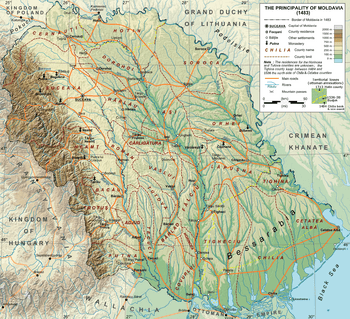Moldavia facts for kids
Quick facts for kids
Principality of Moldavia
Moldova (Țara Moldovei) (Romanian)
|
|||||||||||||
|---|---|---|---|---|---|---|---|---|---|---|---|---|---|
| 1346–1859 | |||||||||||||

Moldavia under Stephen the Great, 1483
|
|||||||||||||
| Capital | Baia/Siret (1343–1388) Suceava (1388–1564) Iași (Jassy) (1564–1859) |
||||||||||||
| Common languages | Romanian (Old Romanian) (local dialect also named as Moldavian), Old Church Slavonic (in early official use) | ||||||||||||
| Religion | Eastern Orthodox
Minority
|
||||||||||||
| Government | Principality | ||||||||||||
| Princes of Moldavia (Voivodes, Hospodars) | |||||||||||||
|
• 1346–1353 (first)
|
Dragoș | ||||||||||||
|
• 1859–1862 (last)
|
Alexandru Ioan Cuza | ||||||||||||
| History | |||||||||||||
|
• Foundation of the Moldavian mark
|
1346 | ||||||||||||
|
• De jure union with Wallachia
|
5 February [O.S. 24 January] 1859 | ||||||||||||
| Currency | Taler | ||||||||||||
|
|||||||||||||
| Today part of | |||||||||||||
Moldavia (in Romanian: Moldova) was an important region in Eastern Europe. It existed as a separate country, called a principality, from the 14th century until 1859. In that year, it joined with another principality called Wallachia. This union created the foundation for the modern country of Romania.
Over time, Moldavia included different areas. These were Bessarabia (which had a part called Budjak) and much of Bukovina. Today, the largest part of Bessarabia is the independent country of Moldova. The rest of Bessarabia and the northern part of Bukovina are now part of Ukraine.
Contents
Moldavia: A Look Back in Time
Moldavia was a powerful state in Eastern Europe for over 500 years. It played a big role in the history of the region.
How Moldavia Began
Moldavia started around 1346. It was first a border area, or "mark," of the Kingdom of Hungary. Soon, it became an independent principality. This meant it was a country ruled by its own prince. The first known ruler was Dragoș.
Who Ruled Moldavia?
The rulers of Moldavia were called Princes, Voivodes, or Hospodars. These titles meant they were the main leaders. They had a lot of power over the land and its people. Many princes fought to keep Moldavia strong and independent.
Important Capitals of Moldavia
Moldavia had several capital cities over its long history:
- Baia and Siret were early capitals from about 1343 to 1388.
- Suceava became the capital in 1388 and stayed so until 1564. It was a very important city for trade and defense.
- Iași (also known as Jassy) was the final capital from 1564 until Moldavia joined with Wallachia in 1859. Iași grew into a major cultural and educational center.
Moldavia and the Ottoman Empire
For a long time, Moldavia was a vassal state of the Ottoman Empire. This means it had to pay money (tribute) to the Ottoman Empire. It also had to follow some of the Ottoman Empire's rules. However, Moldavia still kept some of its own independence and its own rulers. This relationship lasted from 1514 until 1859.
The Union with Wallachia
In 1859, a very important event happened. Moldavia decided to unite with its neighbor, Wallachia. This union was a big step towards creating a single, larger country. On February 5, 1859, Alexandru Ioan Cuza was chosen as the ruler of both Moldavia and Wallachia. This event officially created the United Principalities. These principalities later became the modern country of Romania.
Moldavia Today
Even though Moldavia as a country no longer exists, its history and culture are still very important. Its former lands are now part of three different countries:
- Most of the historical region is now part of Romania.
- A large part is the independent country of Moldova.
- Some northern areas are part of Ukraine.
The legacy of Moldavia can be seen in the language, traditions, and historical sites across these regions.
Images for kids
-
Ruins of the Roman Catholic Cathedral established by Transylvanian Saxon colonists at Baia (German: Moldenmarkt), Suceava County, Romania
-
Equestrian statue of Moldavian Prince Stephen the Great in Suceava
-
Neamț Citadel in Târgu Neamț, Romania
-
Soroca Fort in Soroca, Republic of Moldova
-
Akkerman Fortress in Cetatea Alba, Ukraine
-
Khotyn Fortress on the Dniester River, present-day Ukraine, then bordering the northern frontier of the Moldavian Principality and southern Polish–Lithuanian Commonwealth
-
In 1600, Michael the Brave became Prince of Wallachia, of Transylvania, and of Moldavia.
-
The Principalities of Moldavia and Wallachia in 1782, Italian map by G. Pittori, since the geographer Giovanni Antonio Rizzi Zannoni
-
The siege and capture of Iași in 1788 by the Russian Army






















